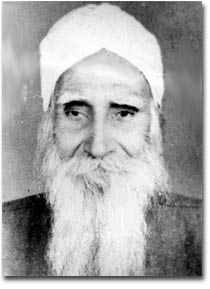Ghadriite Harnam Singh Tundilat
HARNAM SINGH TUNDILAT (1882-192), a Ghadr revolutionary was born, 11 March 1882, the son of Gurdit Singh, a farmer of modest means, of Kotla Naudh Singh, in Hoshiarpur district of the Punjab. He learnt to read Gurmukhi in the village Dharamsala and joined the Indian army as he grew up. On 12 July 1906, he emigrated to Canada and then to California in the United States of America in December 1909.
There he worked in a lumber mill at Bridalville, Oregon. He attended a meeting of Indian immagrants at Portland in the beginning of 1912 which led to the formation of Hindustani Workers of the Pacific Coast, later renamed Hindi Association of the Pacific Coast, but populally known as the Ghadr Party. The first meeting of the Association was held On 31 March 1913 at Bridalville, where Harnam Singh was elected secretary of the local branch. In party meeting at Sacramento on 31 December 1913, he was made a member of the central executive. Meanwhile, it had been decided to launch a weekly paper, Ghadr literally rebellion, to be published in Urdu, Punjabi, Hindi and other lndian languages. The first issue of the Ghadr in Urdu appeared on 1 November 1913, and its Punjabi edition followed in January 1914. To begin with, Lala Hardayal was its editor, with Kartar Singh Sarabha and Raghubir Dayal as assistant editors. Later, Harnam Singh, with a few others, was also invited to join the editorial board. He wrote verse in Punjabi and contributed to the paper poems burning with patriotic fervour. He also acted as a bodyguard to Lala HarDayal, the party general secretary.
With the expulsion of Lala Hardyal from America in April 1914, party work at the Yugantar Ashram, its headquarters in San Francisco, was resdistributed. Harnam Singh was made editor of the Ghadr, with four others to assist him. Talk of an impending war netween Great Britain and Germany was in the air, and the programme of the Ghadr Party was directed towards a planned rebellion in India as the British got involved in Europe. While Udham Singh Kasel started imparting military training to party volunteers and Kartar Singh Sarabha went to the eastern coast to train as a flier-cum-aircraft mechanic, Harnam Singh learnt bomb making from an American friend. During an experiment, on 5 July 1914, his left hand was blown of as a result of which his left arm had to he amputated well above the wrist. He was given by his comrades the new name of Tundilat, The armless Lord. The epithet contained an ironic allusion to Sir Henry Hardinge, governor-general of India (1844-48) at the time of the first Anglo-Sikh war, who was called by the Punjabis Tundilat because of his having lost a limb during the Napoleonic Wars.
Upon the outbreak of World War I on 25 July 1914, the Ghadr Party directed its members and sympathizers to return to India forthwith Harnam Singh came via Colombo and arrived in the Punjab on 24 Decenber 1914 Disguised as a holy man in ochre robes, he roamed the Doaba villages preaching thc message of Ghadr. He also contacted, at the behest of the party, troops in Rawalpindi, Bannu, Nowshera and Peshawar cantonments. The plan for a military and general rising on 21 February 1915, later advanced to 19 Fehruary 1915, having tailed owing to betrayal by a police agent smuggled into the party cadre, Harnam Singh Tundilat along with Kartar Singh Sarabha and Jagat Singh of Sursingh escaped to the North-West Frontier Province to seek temporary refuge in Afghanistan and plan afresh.
But receiving no support from that government, they turned back and arrived, on 2 March 1915, at Wilsonpur, a remount farm in Chakk No. 105 in Shahpur (Sargodha) district, to stay with one Rajindar Singh, a military pensioner and an acquaintance of Jagat Singh, himself an ex-soldier. Rajindar Singh however, betrayed them to the police through Risaldar Ganda Singh of Gandivand, who held charge of a remount farm. All three were arrested and taken to Lahore Central Jail, where they were tried in what is known as thc First Lahore Conspiracy case. The trial by a special tribunal under the Defencc of India Act 1914 began on 26 April 1915 and the judgement was delivered on 13 September 1915. Harnam Singh Tundilat was one of the twenty-four sentenced to death with forfeiture of property.
The Ghadr leaders refused to file an appeal, but the Viceroy on his own commuted the death penalty into life imprisonment in the case of seventeen of them, including Harnam Singh. He served six years in the Andamans and nine years in other jails in Madras, Pune, Bombay and Montgomery. On 15 Scptember 1930, he was released on medical grounds. He served another term in jail from 1941 to 1945. At the time of intercommunal turbulence in 1947, he helped Muslim residents of his village and the surrounding area to evacuate to refugee camps. He died on 18 September 1962 after a brief illness.
Harnam Singh was a revolutionary poet and a writer of prose of considerable merit. Three collections of his poems have been published Harnam Lafairan, Kurltl SudSIar and Harnam Sandesh. His prose works include Sacheha Sauda, Akhlaq te Mazhab, both in Punjabi, and Mazhab aur Insaniat, in Urdu.

